Port Stanley, South Atlantic Ocean
The John R Kelley was built by Goss & Sawyer out of Bath Maine in the United States of America in 1883. At the time she was said to be the biggest sailing ship ever built in the USA, a “full-Rigged Ship”of 2,364 Tonnes, built for carrying big cargoes, known colloquially as a “windjammer” for her huge yardage of sail, between New York and San Francisco……but this is not a story about One ship alone, it would be foolish to write of the John R Kelley without at least passing mention of the Cyrus Wakefield, another American Schooner also frequently sailing the New York to San Francisco trade route and also renowned, but for far darker reason…..
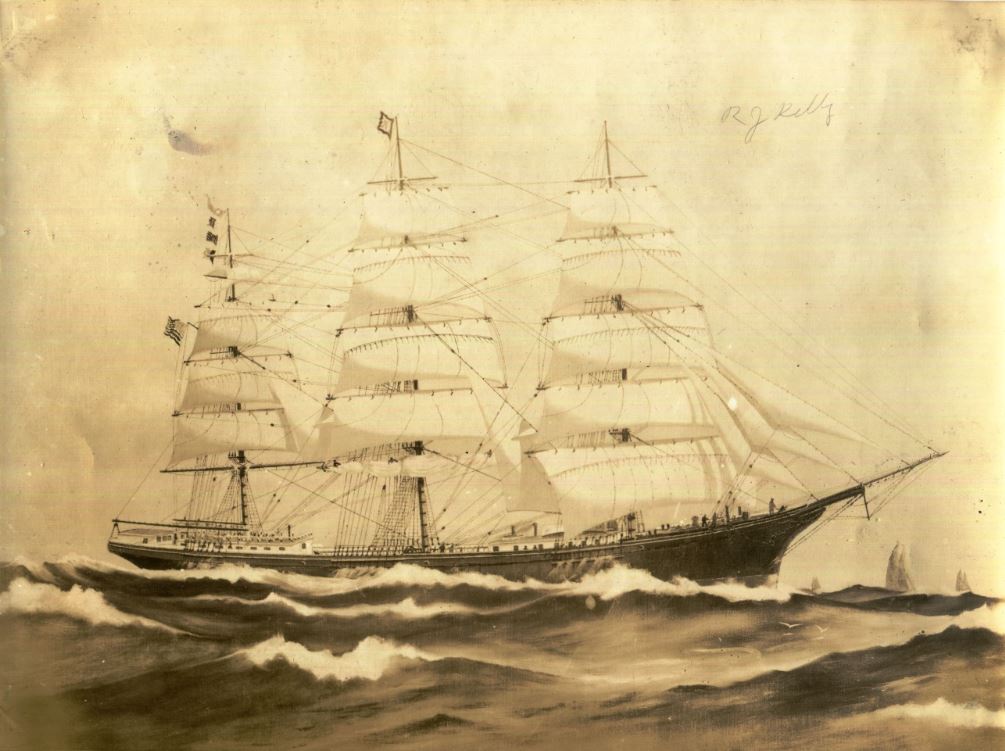
The John R Kelley was one of three ships (including the Ships: E F Sawyer & Charles E Moody) commissioned on the retirement of master mariner, John R Kelley, born in Phippsburg June 14th 1828. John Kelly had been captain of the ship “Genoa” at the age of 23, following an apprenticeship under his father (Captain Francis Kelley) from the age of 16 (Little, George T: “Genealogical and Family History of the State of Maine” in “Kelley (IV) Captain John R.”: Lewis Historical Publishing Co New York 1909). The shipyard of Guy C Goss and Elijah F Sawyer (Goss & Sawyer) was started in 1865 and lasted under that name until 1873, when they were joined by Benjamin F Packard, becoming Goss Sawyer & Packard until 1883, just a year before the John R Kelley was launched and the yard became the New England Shipbuilding Co (Online resource: shipbuildinghistory.com/shipyards/emergencylarge/texas.htm: Texas Steamship Company, Bath ME. Accessed 10/09/2020)

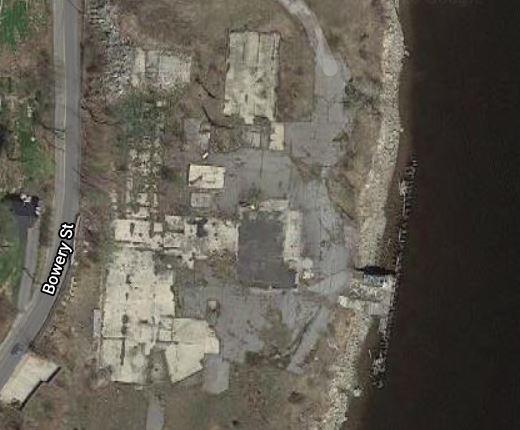
Although the New England Shipbuilding Co, latterly named the Texas Steamship Company, closed in 1921 the site can still be visited in Maine, where Bowery St and what remains of the Pier and slipway on the Kennebec River still exist and, up to the date of publishing this post, have yet to be re-developed. The Cyrus Wakefield, another three masted Sailing Ship, was launched in 1882 just over a year before the John R Kelley, in Thomaston, another Maine Shipbuilding yard, just 40 miles from the Bowery St yard of Goss Sawyer & Packard
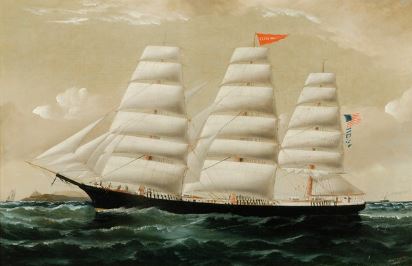
The New York to California sailing route had been established during the California Gold Rush of 1848 to 1855 when tens of thousands from across the USA, and indeed the globe, converged to pan the streams of California to find their fortunes, or to feed the logistics behind their need to survive whilst trying. Everything from grain to shovels, pots and pans to horses and carts were carried across the country or around Cape Horn, the record for that route was held by a clipper, the Flying Cloud, which completed the journey, some 12,000 miles, in just 89 days, lightning fast considering the cross country route, at its shortest (through Panama) usually took between 120 to 200 days to travel the 2,445 miles in a wagon train, with all the trouble that implied….. Although the Panama Canal had been started in 1881, it would not be completed until 1914 and the sailing ship attraction, if not the speed itself, (which was mostly comparable with that of the land route) was a considerably cheaper journey which involved less personal effort than the wagon train alternative
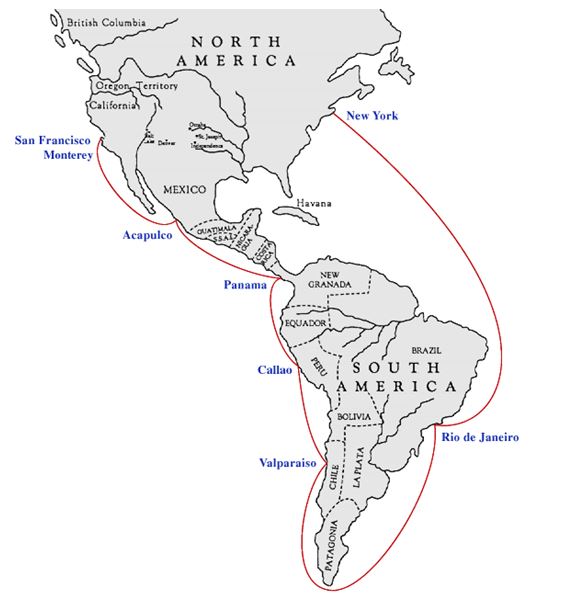
Sea Voyage, New York to California, Pre-Panama Canal (Web Illustration)
Now the seafarers of the Cape Sail-ship and Clipper days were a special breed, known as “Cape Horner’s” these were tough men used to harsh conditions and the often appalling weather, almost normal when sailing around the Southernmost tip of South America, (a desolate and mostly inhospitable place in those days) and the coast of Patagonia. To join the crew of a sailing ship like the John R Kelley or the Cyrus Wakefield even in the late 1800’s meant you either knew what you were in for or you wanted to escape from something even worse….. if that is imaginable? Whilst the Master of the John R Kelley, Captain O E Chapman, was known as an outstanding mariner, respected amongst all those that sailed the Southern route, the Master of the Cyrus Wakefield was held in a different light amongst his peers, indeed Captain Frederick Thomas Henry, his First Mate F Williamson and Second Mate Leonard, seem to have been reviled by most that sailed with them (San Francisco Call, 31 August 1898: “CRUELTY ON THE HIGH SEAS”) the Boatswain (Bosun) of the Cyrus Wakefield, J A Jansen is quoted as saying “I have travelled in some pretty hard ships, but the Cyrus Wakefield takes the cake………When they got tired of beating us they started in and threw our clothes overboard, and when the men said they would have the law on them Second Mate Leonard laughed and said. ‘We’re going to Frisco; there’s no law in that hole” and, in validation of that piece, the Sacramento Daily Union reported (Sacramento Daily Union, September 01st 1898: “CRUELTY CHARGED. Serious Accusations Against Mates of Bark Cyrus Wakefield.”) “To-day members of the crew of the bark Cyrus Wakefield, which arrived here last night from Baltimore, swore out warrants for the arrest of First Mate F. Williamson and Second Mate Leonard, charging them with brutality, assault and other violations on the high seas” The two captains and the conditions on board the two sailing ships could not have been more different it would seem
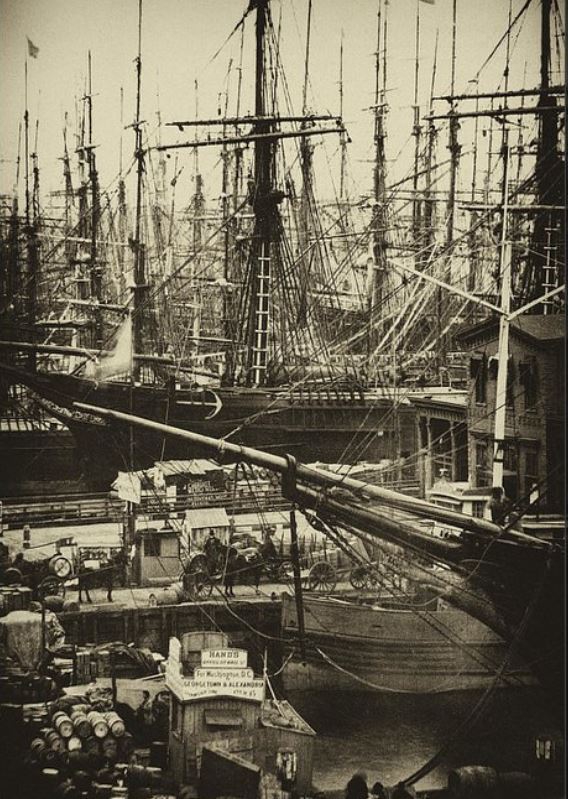
So the journey’s begin, the John R Kelley left New York for San Francisco on March 15th of 1899, unknowingly on her last journey, all must have seemed well to Captain Chapman, his holds full of the general cargo expected to make some $150,000, at least that was the value placed on it with insurers, although the John R Kelley itself was not insured, despite the owners (John R Kelley and James F Chapman & Co) placing a value of $75,000 on her……The list of cargo is known well, detailed in the San Francisco Call 17th June of 1899 (San Francisco Call, 17th June 1899, Volume 86 No 17: “LOSS OF THE AMERICAN SHIP JOHN R. KELLY”) and is seemingly quite likely to have been a significant “overload” in modern terms: 200 tons No 1 Tonowanda Scotch Pigiron, 26 barrels iron casters, 89 cases linoleum, 27 cases and half a barrel hardware, 400 drums caustic soda, 85 cases chalk crayon, 111 barrels iron pipe fittings, 650 kegs horseshoes, 6 cases blacking, 76 cases spools, 6 cases leaf tobacco, 5 cases hardware, 20 cases hair renewer and whisker dye, 60 bags ginger root, 50 bags cocoa dust, 1 barrel iron castings, 2 barrels sumac extract, 66 bundles 1 barrel stove castings, 890 kegs horseshoes, 3 bales burlap, 3 barrels varnish, 950 pieces boiler tubes, 3909 pieces 289 bundles welded iron pipe, 443 bars steel, 10 cases ball blue, 9 cases blacking, 440 plates iron, 80 packages marble, 193 packages pumps, 50 cases cider, 100 cases sheep dip, 294 bundles welded iron pipe, 405 bales carpet lining, 217 iron range boilers, 143 boxes 4 casks ink, 115 boxes mucilage, 31 cases cotton, 5 crates candles, 7 boxes 1 barrel iron strap hinges, 1 barrel whiting, 1 pump (cased), 40 barrels stamped ware, 20 crates chair seats, 320 steel beams, 46 channels 3037 steel rails……….You can read the rest for yourselves below but by now this is looking like a hell of a cargo and perhaps even a very dangerous load, unless there is an element of the Atlantic Conveyor lading list going on (see the Falkland islands war reports of 1982 and the “claimed” cargo of the vessel Atlantic Conveyor, sunk in the conflict, where every army stores warrant officer involved claimed every piece of lost kit they had on inventory…… “apparently” your honour)
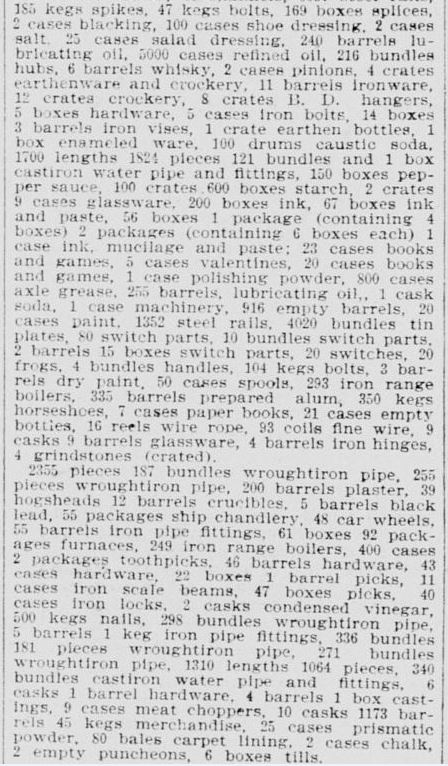
The John R Kelley was a big ship, 256 feet 9” long, 45 foot wide and a draft of 27 feet 8” and a net weight of 2,255 tonnes laden, as already mentioned, perhaps the biggest sailing ship in the USA merchant fleet of the time, however that cargo list seems quite incredible to me, perhaps there is someone who can spend the time estimating the weight and size of such an inventory, sadly that won’t be me, I shall just remain amazed at such a scale and scope of cargo, and of the belief it must in some way have contributed to the damage caused to the John R Kelley whilst en route and approaching Patagonia. The damage said to have “disabled” the ship forcing Captain Chapman to re-route to Port Stanley in the Falkland Islands in order to make repairs, the San Francisco Call reporting (same issue and piece) that “….it is a very dangerous place to enter and the chances are that something gave way at a critical moment and the ship went ashore” The John R Kelley just failed to make it to Port Stanley, becoming unmanageable off Cape Pembroke in the Falkland Islands, and anchored up near Tussac Island 25th June of 1899, in violent weather that prevented any rescue attempt until the next day
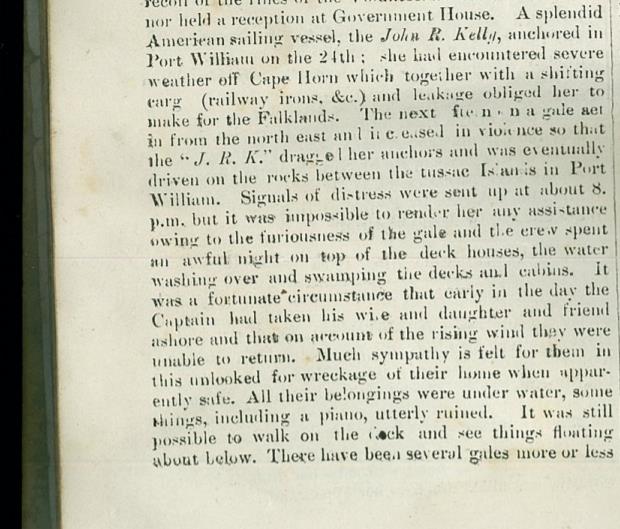
News came to Port Stanley of the fate of the John R Kelley following a desperate dash by Charles Coulson (Jr), ward to the lighthouse keeper on Pembroke Point, a Mr James Hocking. Coulson rode 7 miles in appalling conditions to Port Stanley to raise alarm that the James R Kelley was floundering on the rocks off Tussac Island, an effort that prompted the American Consul of the time to write: (On Line Resource: falklandsbiographies.org/biographies/129 accessed 15/09/2020) “I cannot exaggerate the conditions and the darkness caused by the wild storm. It was terrible and no reward is too much for this noble boy” The journey had taken Charles Coulson an hour and a half, risking death throughout, riding the banks of Cape Pembroke, but the act of unselfish bravery resulted in the launch “Sissy” making several attempts from Port Stanley to rescue those aboard the John R Kelley, an act that resulted in a presidential award to Sissy’s captain from the USA in gratitude
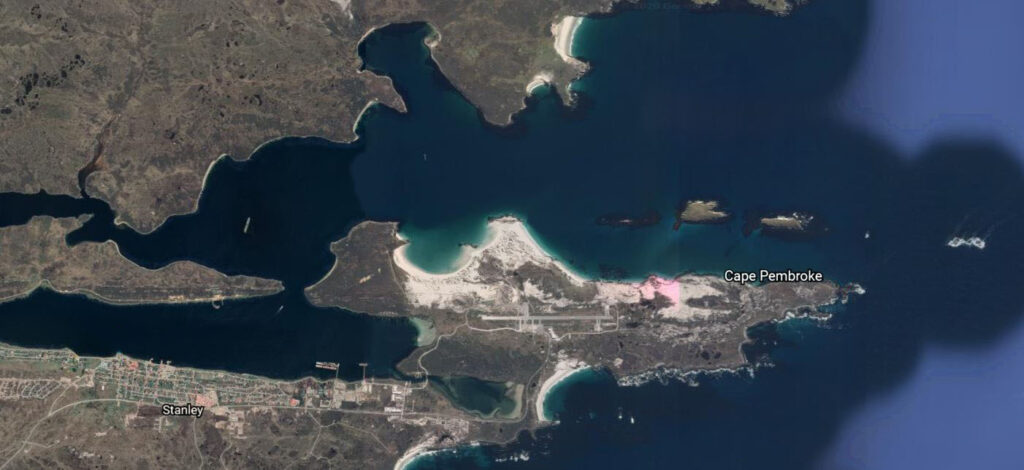
So to the Cyrus Wakefield, which sailed from New York on the 04th April of 1899 bound for San Francisco and undoubtedly taking the same route as the John R Kelley, although if previous reports are to be believed, conditions on board would have been very different for those crewing the ship. The master on the journey was Captain Henry and the First mate still Williamson, clearly both had managed to avoid answering the charges of brutality and assault brought against them in August of 1898…..But, as always karma has a place in every story, and in every man’s path…… (San Francisco Call 05th July 1899: “CAUGHT IN A STORM OFF CAPE HORN”) “The American ship Cyrus Wakefield, now on her way here from New York, has been particularly unfortunate this voyage. Heavy weather was encountered off the Horn, and in consequence the vessel was damaged and had to put into Port Stanley. Captain Henry died and was buried while the vessel was in the Falkland Islands” Now it may seem fortuitous that such a man as Captain Henry might be severely injured in a storm whilst navigating around Cape Horn, but when you add in a report that the First Mate Williamson was injured during the same storm, it might perhaps provoke a feeling of impending unease, even a deep seated curiosity as to the circumstances of such injuries…….
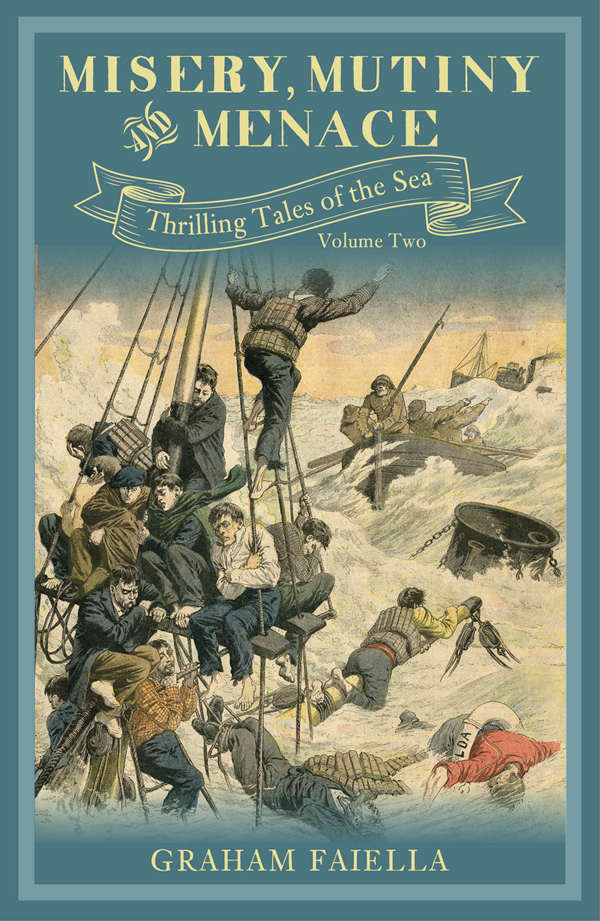
I spent quite some time looking for reports contemporary to the time, as men of such violence as Henry and Williamson seldom come to entirely “natural” endings, it did not take long to find Graham Faiella’s book “Misery, Mutiny and Menace: Thrilling Tales of the Sea (Vol. 2)” (Published by The History Press) in which claims are made that Williamson had argued with Captain Henry continually since leaving New York and that Williamson eventually took a hammer to Captain Henry and used the heavy seas breaking over the ship to cover his murder. Is this just a flight of fancy to sell a “Penny Dreadful” article in a book unashamedly seeking a ghoulish audience by its title alone? If it were not for the charges laid in August of 1898 then I might have given scant regard to such an accusation, however, the background allegations of brutality towards previous crews on the Cyrus Wakefield means to do so would be perhaps ill-considered…..
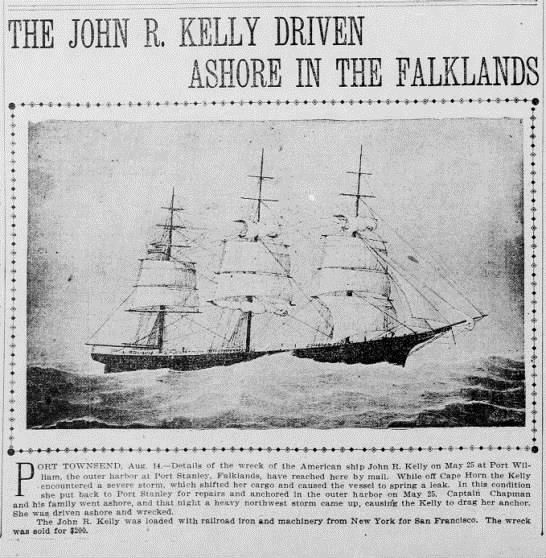
So the John R Kelley limped into Port Stanley Approaches in the midst of a horrendous storm, no one aboard was injured much more than bruising in the maelstrom of Cape Horn in May of 1899 and yet on the Cyrus Wakefield a lesser weather set, in June of the same year, supposedly caused the death of the Captain and the serious injury of the First Mate…….unless you lean more towards the accounting of events in Graham Faiella’s book…. The account here has First Mate Williamson responsible for the murder of Captain Henry and using poor weather as the cover-up: “On June 15, about 7:30 p.m., shipped a heavy sea on the port quarter, which struck Captain Henry and knocked him off the after-house down on the deck. He struck against some iron and received some terrible injuries to his chest, back and hips, and his head was cut to pieces. We carried him into the cabin and did everything in our power to restore consciousness, but failed, and Captain Henry died at 8:20 p.m.” (Log Book Entry, Cyrus Wakefield, First Mate Williamson, Quoted In Faiella, G. “Misery, Mutiny and Menace: Thrilling Tales of the Sea (vol. 2)”, History Press) The basis for an accusation of murder by First mate Williamson comes from testimony of the steward of the Cyrus Wakefield, Thomas Visiga, who further claims others who witnessed the event were paid off by Williamson on reaching Port Stanley and subsequently dispersed about the globe, making it impossible to prove the events (Visiga, T. Quoted In Faiella, G. “Misery, Mutiny and Menace: Thrilling Tales of the Sea (vol. 2)”, History Press) “The Captain and mate were always quarrelling, mate Williamson did not like the old man, and told him so on numerous occasions. On the night of the killing the mate got a hammer from the carpenter at a quarter to 7 and when he came down from the poop he still had the hammer in his hand and there was blood on it” When the Captain is eventually brought in to the cabin and laid on his bed Visiga has it that Captain Henry was still alive and describes events: “Captain Henry was carried in from the deck and laid out on the cabin floor. The mate went to the medicine chest and, making up a mixture, tried to get the Captain to take it. The dying man rolled his head and I heard him say, “No, no! don’t let him, Mr. Johnson” His mouth was forced open, however, and Mr. Williamson made him swallow it, saying, “Drink it down; it will do you good.” About 8:30 p.m. the Captain died.”

The assertion quoted in “Misery Mutiny & Menace…” by Thomas Visiga originally comes from the San Francisco Call of 12th November 1899 and goes on to allege “When we got into Port Stanley the mate took possession of the ship’s money and paid off the man who was at the wheel when the captain and mate were quarrelling near the wheelhouse. He also paid off the four men who took refuge in the rigging just before the sea broke aboard and who had seen everything that took place. Then he left the ship himself and Captain Chapman of the John R Kelly took command” As Thomas Visiga goes on to say First Mate Williamson “left the Ship” it would seem, if everything Visiga alleges is true, the foul crime against Captain Henry went unpunished and the Laudanum administered by Williamson, finally ended Captain Henry’s suffering and ultimately his life
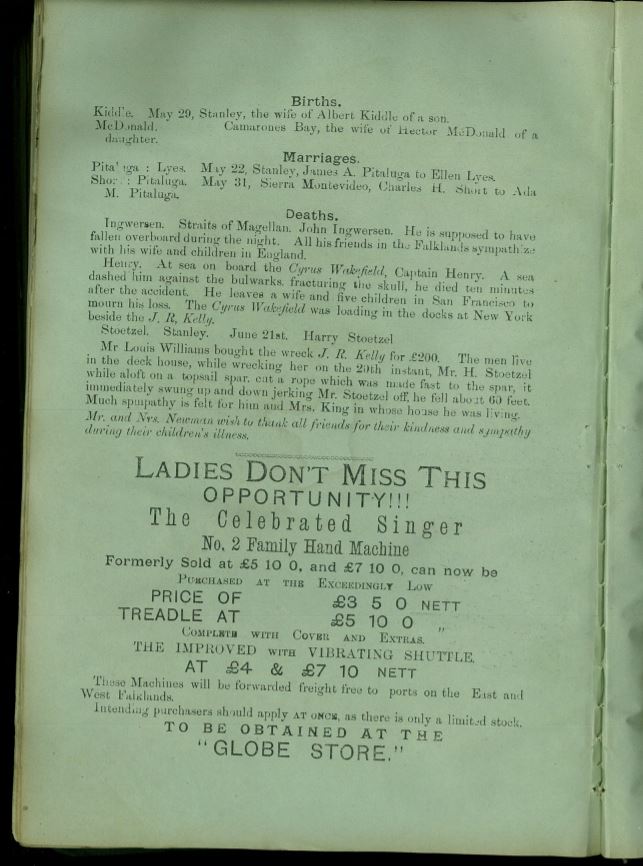
There are opportunities to look further into the case if an autopsy was properly carried out in Port Stanley on the body of Captain Henry, perhaps there was a report of events logged with the Port Stanley judiciary at the time? For two such prestigious sailing ships to have entered Port Stanley waters, one to flounder just in the last few miles to the port itself and one to dock with the Captain dead, to have gone mostly “unremarked” seems bizarre. If, as Visiga alleges this was a foul murder at sea, how was the crew allowed to disperse from port Stanley, without question, on the word of someone (Williamson) who had been subject to a warrant for arrest, on grievous assault charges in New York so recently?

Faiella’s book and Visiga’s San Francisco Call allegations raise serious questions as to the conduct of those in command of the Cyrus Wakefield and perhaps also the procedures surrounding the handling of the death of Captain Henry on arrival of the Cyrus Wakefield at Port Stanley. If, however, the allegations of Thomas Visiga have embellished Captain Henry’s death, questions surrounding motive must be investigated, what would such allegations do for Visiga, those responsible had vanished, unpunished and into history from Port Stanley. There is unlikely to have been financial gain for Visiga from the story itself, and what benefits Visiga in the telling anyway, revenge against poor treatment by Williamson perhaps? No mention of any conflict between him and Williamson is made by Visiga during his telling of the voyage, it seems the story has much more to give, something a criminal historian might take an interest in, it would certainly make a great additional entry into the history of Port Stanley and those who “rounded the Horn”….men of iron, in ships of wood!
One thing of this story is, however, certain, the death of Captain Frederick Thomas Henry is unlikely to have been mourned by those who sailed on the Cyrus Wakefield, equally, many who sailed on that “Hell-Ship” would be horrified, if unsurprised, to find First Mate Williamson might have escaped justice for murder
So to the John R Kelley of 1996, and again we return to Exercise Southern Craftsman and our final Falkland Island diving location, based out of Port Stanley, my little Red Log book records: 03 February 1996, my 167th dive “Ran aground 1892 steam ship SS Kelly, on Kelly’s Rock outside Port Stanley S.A. wedged between two outcrops of rock. Heavily Kelped at the surface which when underwater gives the effect of a forest round the remains. Really atmospheric lighting! Viz about 8m. The hull is timber, Copper plated at the waterline & below, near enough all of the length is still there but most of the bulk of the hull is gone plenty of marine life & a couple of large fish loads of nooks & crannies & holes – great dive” I have no idea who told us the John R Kelley was a steamship and I excuse my ignorance in not correcting that in my wreck log simply by lack of experience and a desire to report what was seen rather than what was not, I saw no boiler, but that wouldn’t mean to me at the time that there “were” no boilers, I saw no real pipe-work that would have been associated with a steamship of the era either, but again, the condition of the hull, filled mostly with the decay of a hundred plus years and the marine life obscuring detail, would not have caused me to comment either
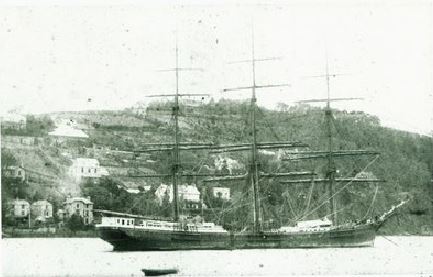
I knew there were sailing ships of that period that had been converted to dual use, mounted with steam engines and sail, who knew if this had been one such ship, the hull was clearly large enough to have accommodated that type of arrangement. I note the date we had been given for the sinking was as inaccurate as the type of ship we were diving, but such was “as it was” so to speak, we had done no prior research on the wrecks of the Falklands (as we had not intended to carry out more than general diving in the areas of interest), to find there were wrecks was a surprise to me at the time, beyond those of the 1982 war, from which we had been gallingly and selfishly denied access by the MoD in short order! My recollection of the dive on the John R Kelley is one of real enjoyment of the kaleidoscope effects the kelp had on the light, she is a shallow wreck at 8-10m maximum and winding along her hull, looking at whatever was about was as much a gentle light show as it was a wreck dive. I mainly recall there was not much of her that was more than one level, her hull almost down to the waterline in most places, some framework evident and a mast spar if I recall correctly, but mostly an interesting, atmospheric root rather than an opportunity for involved investigation in stark contrast to the history of the ship herself
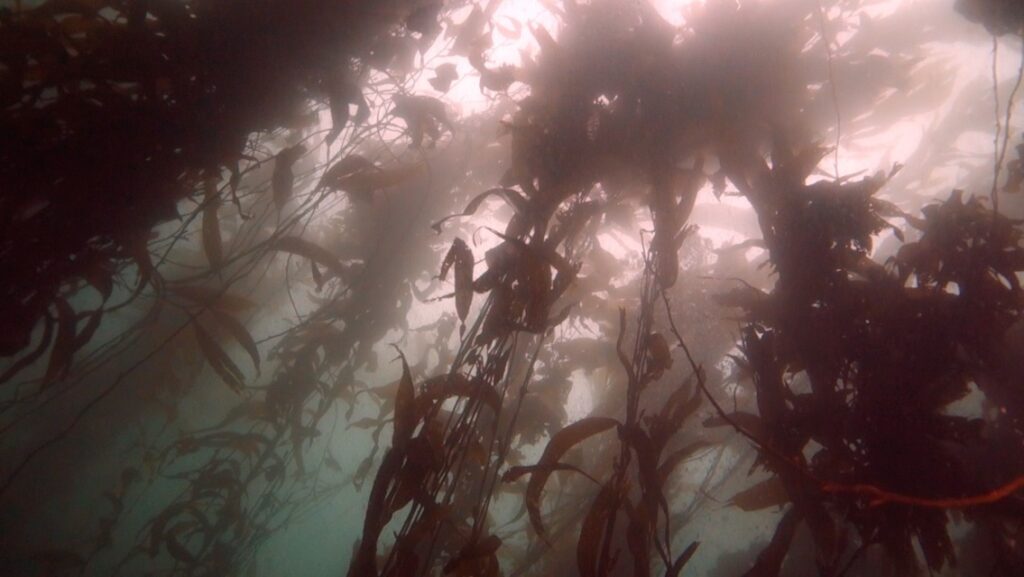
The epilogue of the entwined fates of the John R Kelley and the Cyrus Wakefield leave one ship sunk and irreparable, from which all usable cargo, fixtures and fittings was sold for £200 to a Mr Louis Williams (with the ships pumps being sold the day after for £150), and one ship “captainless” and docked at Port Stanley
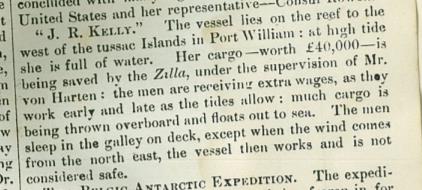
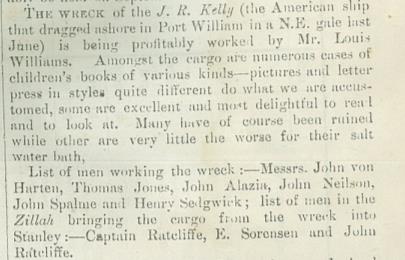
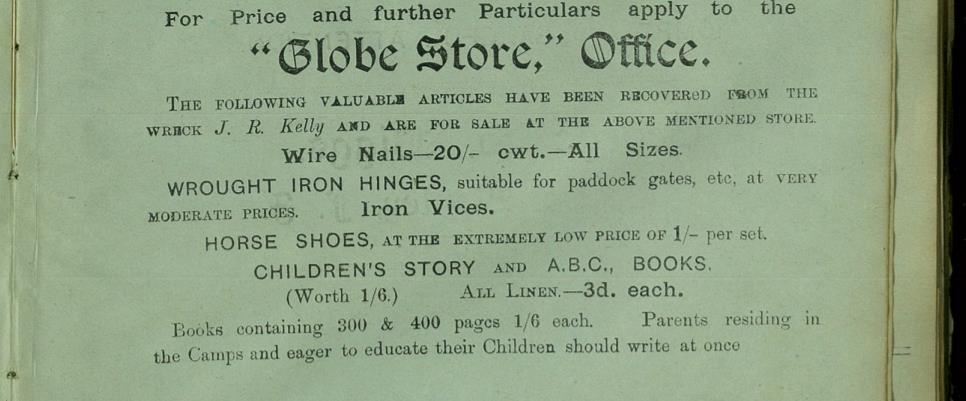
I remember being in the post office in Port Stanley before we left for Weddell Island, at the start of our diving adventures, there were ink bottles in a small cabinet at one side of the counter for sale, marked “from the wreck of the John R Kelley”, I knew if I bought one the chances were it would get broken or lost over the next month of living somewhat rough nomadic existences across the islands, so I let it be and decided I would pick one up on the outward journey back home. As luck would have it, on our return the post office was closed and I left disappointed, it has taken 24 years to now, but with the help of Tara Hewitt from the Falkland Islands Museum & Trust, I have finally managed to keep the promise I made to myself so long ago
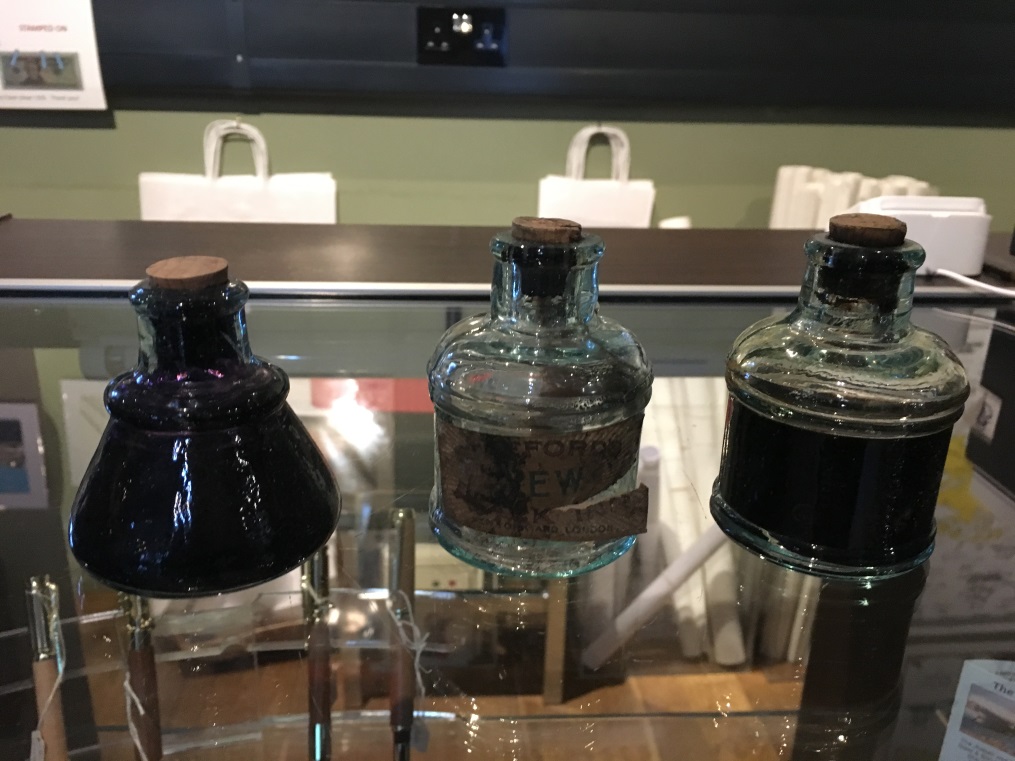
There followed a natural and perhaps ironic twist where Captain Chapman, formerly of the John R Kelley, took charge of the Cyrus Wakefield and brought her, from the dark voyage south from New York, to her eventual delivery of Captain Henry’s body to the port Authority in Stanley, finally in to San Francisco, along with the One remaining crew member, the steward Thomas Visiga, who would go on to tell a story of deceit and an unpunished murderer at large……

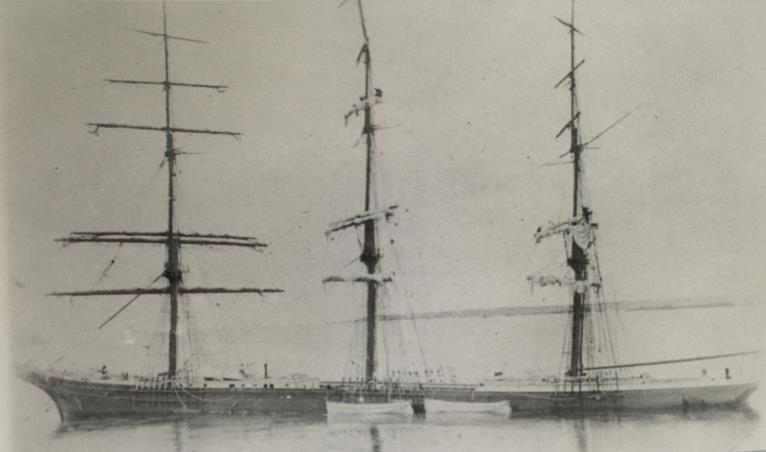
I would like to personally thank Ken Gross at the Walsh History Society & Camden Public library, Tara Hewitt of the Falklands Islands Museum Trust and the Jane Cameron Memorial Archives, to whom I am indebted for their permissions and help with the detail of this piece and for providing some of the photographs used
If you read the comments below you will see Paul Regan of Florida got in touch recently, Paul had the good fortune to purchase one of the navigational instruments off the John R Kelley. I am very envious of such a wonderful piece of the Vessels History and am delighted that Paul has allowed me to publish a picture of the ship’s Octant. An Octant allows the ship’s navigator to use a small mirror to measure the height of the Sun above the horizon giving the ships latitude, it’s position North or South. This when used along with an accurate chronometer and distance travelled would give the ship’s position. I think you’ll agree, it is a wonderful piece in beautiful condition and I’m grateful to Paul for getting in touch……..and if you ever tire of it Paul……

Epilogue
In my research of the John R Kelley over a period of a couple of years I believed I had found as much as I would ever uncover, little did I know at the time…..
As I looked for information on an unrelated wreck, another schooner written up on this site, the Crompton. I was in dialogue with Kelly Page at the (Boston) Maine Maritime Museum and it turned out Kelly had a diary that might be of some interest in respect to schooners that sailed out of the USA…….. The Keene Journal is exactly that, a daily diary (otherwise known as a journal), and was written on the John R Kelley in 1899 by Lydia Ford Keene, teacher of Captain Chapman’s young daughter, who was also aboard and relates their journey on the last voyage and shipwreck of the vessel John R. Kelley. To say I was delighted is somewhat of an understatement, this helped make Christmas of 2021 an exciting time. I suggest anyone interested in the John R Kelley, or schooners and Cape Horner’s, reads what is a wonderful insight into a travelers’ perception of life aboard such ships. I found the detail of a week’s menu very interesting, but there is detail specific to the loss of the John R Kelley that I want to share here:
(Keene, Lydia, F. “Log Book, Lydia Ford Keene” Online Resource: https://archive.org/search.php?query=creator%3A%22Lydia+Ford+Keene%22 Accessed 08/01/2022)
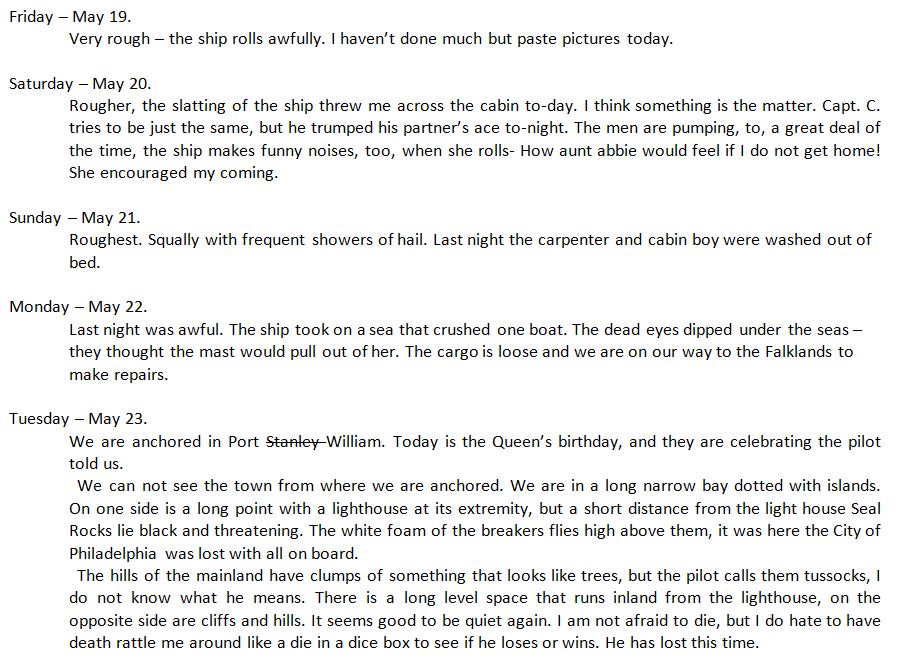
Lydia Keene goes on to describe some of the trivia of the aftermath surrounding the anchorage of the John R Kelley, down the headland from Port Stanley. It is a relief to all aboard as you will see if you read the journal, but Lydia does have a little more to add that I feel compelled to share:
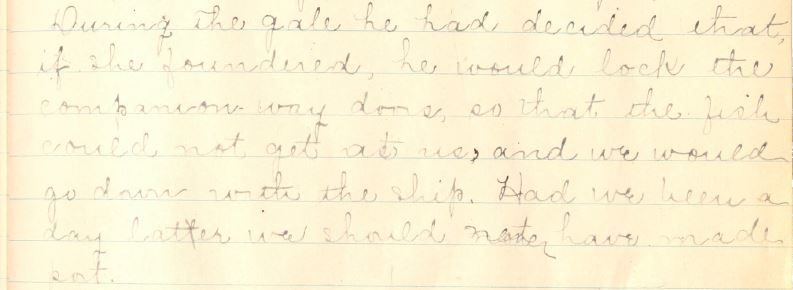
“Capt. C. told me a week ago he had made up his mind that none of us would ever reach port. The heavy cargo had broken the ship. That was why she acted so queerly in the gale, and why the bow sprit rolled from side to side, and why the companion way doors worked up and down. During the gale he had decided that, if she foundered, he would lock the companionway doors, so that the fish could not get at us, and we would go down with the ship. Had we been a day later we should not have made port”
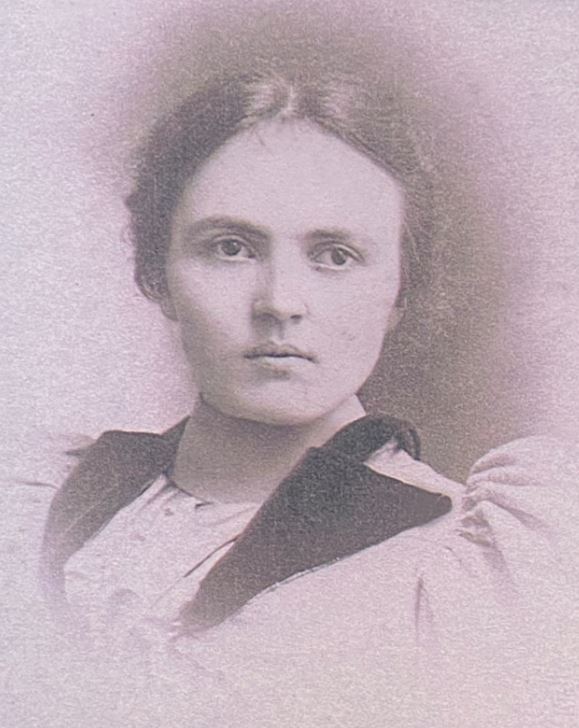
I would like to thank Kelly Page of the Maine Maritime Museum for kindly sharing the Keene Journal, from which these excerpts are taken, and to any living relatives of Lydia Ford Keene who should be very proud of such a fiercely brave and ground-breaking young woman
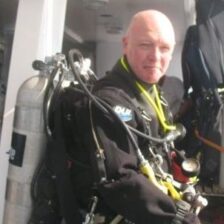
Lydia Keene was my grandmother. I did not know her as she passed before I was born.
I heard stories about her trip from my mother, so was excited to acquire the diary. I have transcribed and researched the story with the intent to publish it
It is nice to know that it is appreciated.
Joan, how wonderful of you to get in touch, could I ask how you found the piece and the site as I do not advertise it anywhere, it is more of a “talking to the wind” piece to amuse me than anything else? I have to say I loved reading your Grandmothers journal it was a fascinating insight and if you do publish please let me know as I will obtain a copy! Thank you so much for dropping by the site & Very Best Regards
Colinj
Colin,
I found your site when I googled John R. Kelly
I have given several presentations in the area. and hope to have a book published this summer.
I will let you know when that happens.
Thank you for your interest.
Joan
Joan, I would love an autographed copy of the book when you get it published, the story is very close to my heart having dived on the wreck, I also own a couple of ink bottles from the cargo, the book would round off my collection nicely so I look forward to seeing it!
Very Best Regards
Colinj
Colin, it has finally happened. I have published a book The Lydessy: Lydia Keene’s 1899 Voyage Around the World, in her own words. with commentary by her granddaughter, Joan H Gregoire. I would like to send you an autographed copy but need instructions on how and where to send it.
I also have a photo of the The Wreck of the John R Kelley under salvage.
Joan,
I literally just sent you an e-mail thanking you for getting back in touch and to congratulate you on your Lydessy! I have asked how to get a signed copy for my collection so if you reply to the e-mail I hope we can get that sorted! I’d love a copy of the salvage picture if you wouldn’t mind to add to the piece. I also found you something I hope you will find of further interest, Captain Gibbon’s journal, the details are in the e-mail, let me know if you can get on line and read it it’s only up to 1891 though so sadly it won’t mention Lydia’s journey
Wonderful to hear from you again! very best regards!
Colinj
Hello Colin,
I am a collector of Marine Chronometers and while trolling EBay last week I came upon an Octant with beautiful complete labels in its carrying box. One of the labels listed the ship owner as the John R Kelley of Bath, ME. When I Googled the name your site came up and as I read the story I got very excited about trying to purchase the Octant. The label is dated 1888 and has a person’s name of FW Breuil listed on it above the name of the ship. I was fortunate enough to purchase it and am very pleased with it. I would gladly share photos of it if you would like. My email is “pwatches@gmail.com”
Paul Regan
Paul, you are a very lucky man as far as I’m concerned, I’d have loved to buy that piece and yes please I’d love to see some photo’s please! My e-mail is colinj@talktalk.net and I look forward to seeing your wonderful reminder of the J R Kelly!
Thank You for getting in touch, glad you liked the piece!
Best Regards Colinj
I have a huge oil of the John R. Kelly from my Grandfather. Painted in 1915 by C. Volquards S.F. 1915 Any info would appreciate, including value.
Charlotte, I count you very lucky indeed! J R Kelly had lovely lines but I am no art expert and these paintings often require a specific artist to do more than a hundred pounds or so. I suggest you have a word with a maritime valuer, an auction house dealing in marine auctions, they will advise you properly rather than getting a less unbiased perspective from on-line auctions. I’d love to see the painting if you can take a shot of it, my e-mail is colinj@talktalk.net if you’d be willing to send a photo? I am currently in Stanley and often sit overlooking the islands the Kelly was lost on at Pembroke, there is a nice piece in the Stanley museum on her too!
Best Regards Colinj
Charlotte,
I hope you are still out there and still have an interest in your painting of the J R Kelly? I have some background on the artist if you’d like, Charles Volquards (1872-1928). I can’t attach it here however if you drop me an e-mail I can send it on to you colinj@talktalk.net
Best Regards
Colinj